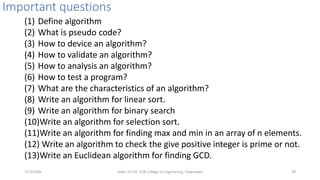The document provides an introduction to algorithms through a lecture on fundamentals of algorithm analysis. It defines an algorithm as a finite sequence of unambiguous instructions to solve a problem. Characteristics of algorithms like inputs, outputs, definiteness and finiteness are discussed. The document also describes various algorithm design techniques like brute force, divide and conquer and greedy algorithms. It explains steps to write algorithms using pseudo code and discusses validating, analyzing, testing programs and specifying algorithms through pseudo code and flowcharts.
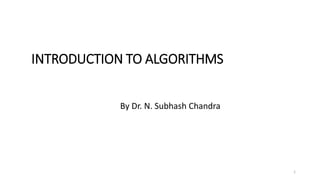
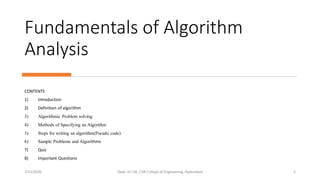
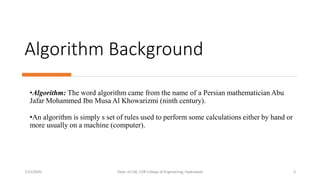
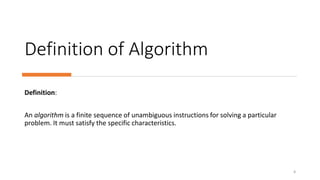
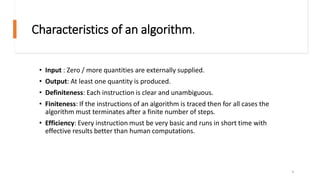
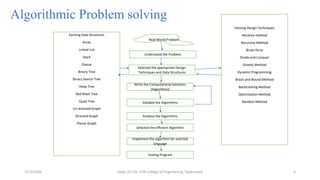
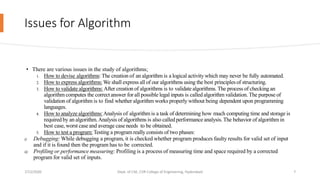
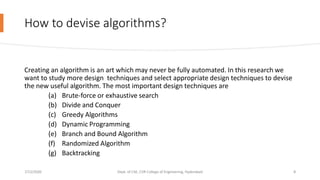
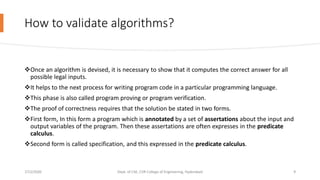
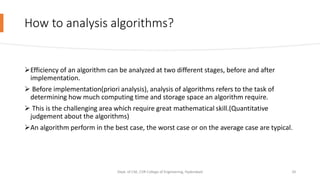
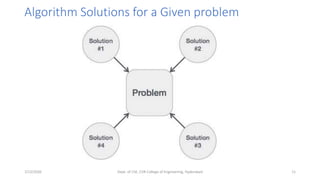
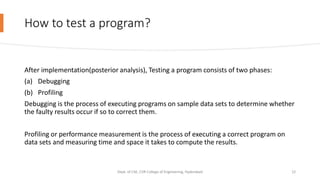
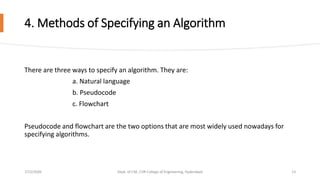
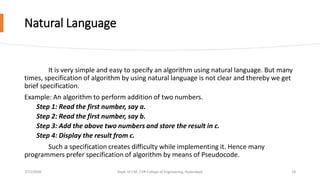

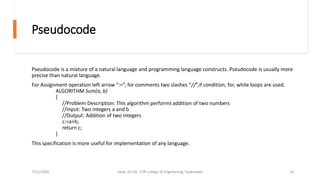
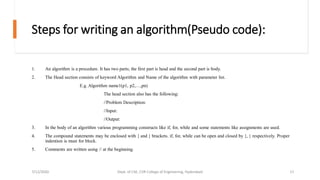
![6. The identifier should begin by a letter and not by digit. It contains alpha numeric
letters after first letter. No need to mention data types.
7. The left arrow “:=” used as assignment operator. E.g. v:=10
8. Boolean operators (TRUE, FALSE), Logical operators (AND, OR, NOT) and
Relational operators (<,<=, >, >=,=, ≠, <>) are also used.
9. Input and Output can be done using read and write.
10. Array[], if then else condition, branch and loop can be also used in algorithm.
7/12/2020 Dept. of CSE, CVR College of Engineering, Hyderabad 18](https://image.slidesharecdn.com/introductiontoalgorithms-200712120726/85/Introduction-to-algorithms-18-320.jpg)
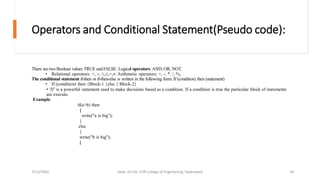
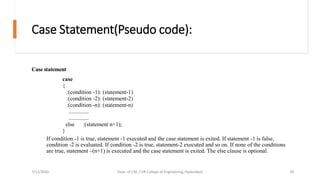
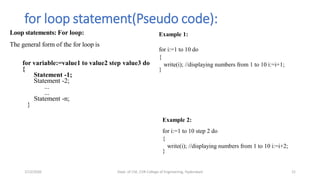

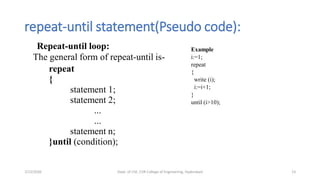
![Break, Array and function Statement(Pseudo code):
Break: this statement is exit from the loop.
Elements of array are accessed using [ ].
• For example, if A is an one-dimensional array, then ith element can be accessed
using A[i].
• If A is two-dimensional array, then (i, j)th element can be accessed using A[i,j].
Procedures (functions): There is only one type of procedure:
An algorithm consists of a heading and a body.
7/12/2020 Dept. of CSE, CVR College of Engineering, Hyderabad 24](https://image.slidesharecdn.com/introductiontoalgorithms-200712120726/85/Introduction-to-algorithms-24-320.jpg)
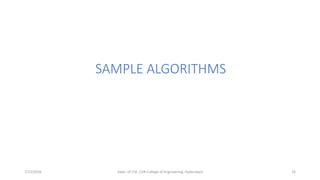
![Write an algorithm to find maximum element in
an array with size ‘n’.
Algorithm Max(A, n)
// This algorithm return the maximum element in the given array
A with size n
{
maximum=A[1];
for i=2 to n do
if A[i]>maximum then
maximum=A[i];
return maximum;
}
7/12/2020 Dept. of CSE, CVR College of Engineering, Hyderabad 26](https://image.slidesharecdn.com/introductiontoalgorithms-200712120726/85/Introduction-to-algorithms-26-320.jpg)
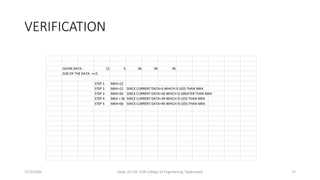
![Write a linear sort algorithm to sort the data in an
array with size ‘n’.
Ans:
Algorithm LinearSort(A, n)
// This algorithm return the sorted(ascending order) array for the given array A with size n
{
for i=1 to n-1 do{
for j=i+1 to n do
if A[i]>A[j] then
{
temp=A[i];
A[i]=A[j];
A[j]=temp;
}
}
return A;
}
7/12/2020 Dept. of CSE, CVR College of Engineering, Hyderabad 28](https://image.slidesharecdn.com/introductiontoalgorithms-200712120726/85/Introduction-to-algorithms-28-320.jpg)
![VALIDATE THE ALGORITHM
7/12/2020 Dept. of CSE, CVR College of Engineering, Hyderabad 29
VERIFY THE ALGORITHM
PASS 1: Fix the first minimum element in the
first position
INDEX A I=1, J=2 I=1,J=3 I=1,J=4 I=1,J=5
1 23 12 12 7 7
2 12 23 23 23 23
3 18 18 18 18 18
4 7 7 7 12 12
5 20 20 20 20 20
RULE 1 : IF A[I]>A[J] THEN INTERCHANGE(A[I], A[J]) ELSE NO-ACTION](https://image.slidesharecdn.com/introductiontoalgorithms-200712120726/85/Introduction-to-algorithms-29-320.jpg)
![3. Write an algorithm for finding max and min in an
array of n elements.
Algorithm MaxMin(A, n)
// This algorithm return the max and min values in a given array A, n- size of the array.
{
maximum:=A[1];
minimum:=A[1];
for i:=2 to n do
{
if A[i]<maximum then maximum:=A[i];
if A[i]>minimum then minimum:=A[i];
}
return([minimum, maximum]);
}
7/12/2020 Dept. of CSE, CVR College of Engineering, Hyderabad 30](https://image.slidesharecdn.com/introductiontoalgorithms-200712120726/85/Introduction-to-algorithms-30-320.jpg)
![4. Write an algorithm for Bubble Sort an array of n
elements.
Algorithm BubbleSort(A, n)
// This algorithm return the sorted(ascending order) array for the given array A with size n
{
for i=1 to n-1 do{
for j=1 to n-i do
if A[j]>A[j+1] then {
temp=A[j];
A[j]=A[j+1];
A[j+1]=temp;
}
}
7/12/2020 Dept. of CSE, CVR College of Engineering, Hyderabad 31](https://image.slidesharecdn.com/introductiontoalgorithms-200712120726/85/Introduction-to-algorithms-31-320.jpg)
![7/12/2020 Dept. of CSE, CVR College of Engineering, Hyderabad 32
BUBBLE SORT
VERIFY THE ALGORITHM
PASS 1: Fix the largest element at last
position
INDEX KEY-A I=1 I=2 I=3 I=4
1 23 12 12 12 12
2 12 23 18 18 18
3 18 18 23 7 7
4 7 7 7 23 20
5 20 20 20 20 23
RULE 1 : IF A[i]>A[i+1] THEN INTERCHANGE(A[I], A[J]) ELSE NO-
ACTION
PASS 2: Fix the second largest data in its
position
INDEX KEY-A I=1 I=2 I=3
1 12 12 12 12
2 18 18 7 7
3 7 7 18 18
4 20 20 20 20
5 23 23 23 23
RULE 1 : IF A[i]>A[i+1] THEN INTERCHANGE(A[I], A[J]) ELSE
NO-ACTION
PASS 3: Fix the third largest data in its
position
INDEX KEY-A I=1 I=2
1 12 7 7
2 7 12 12
3 18 18 18
4 20 20 20
5 23 23 23
RULE 1 : IF A[i]>A[i+1] THEN INTERCHANGE(A[I], A[J]) ELSE NO-
ACTION
PASS 4: Fix the fourth largest data in its
position
INDEX KEY-A I=1
1 7 7
2 12 12
3 18 18
4 20 20
5 23 23
RULE 1 : IF A[i]>A[i+1] THEN INTERCHANGE(A[I], A[J]) ELSE
NO-ACTION](https://image.slidesharecdn.com/introductiontoalgorithms-200712120726/85/Introduction-to-algorithms-32-320.jpg)
![5. Write an algorithm for Selection Sort an array of n
elements.
Algorithm SelectionSort(A, n)
// This algorithm return the sorted(ascending order) array for the given array A with size n
{
for i:=1 to n-1 do{
pos:=i;
for j:=i+1 to n do{
if A[j]<A[pos] then pos:=j;
}
temp=A[pos]
A[pos]:=A[i];
A[i]:=temp
}
return(A);
}
7/12/2020 Dept. of CSE, CVR College of Engineering, Hyderabad 33](https://image.slidesharecdn.com/introductiontoalgorithms-200712120726/85/Introduction-to-algorithms-33-320.jpg)
![7/12/2020 Dept. of CSE, CVR College of Engineering, Hyderabad 34
SELECTION SORT
VERIFY THE ALGORITHM
PASS 1: Fix the first min data in its positon
INDEX KEY-A I=1,pos=2 I=1,pos=2 I=1,pos=4
I=1,
pos=4
1 23 23 23 23 7
2 12 12 12 12 12
3 18 18 18 18 18
4 7 7 7 7 23
5 20 20 20 20 20
RULE 1 : Find the minimum element position and interchange A[i] and A[pos]
PASS 2: Fix the second minimum data in its positon
INDEX KEY-A I=2, pos=2 I=2,pos=2 I=2, pos=2
1 7 7 7 7
2 12 12 12 12
3 18 18 18 18
4 23 23 23 23
5 20 20 20 20
PASS 3: Fix the third minimum data in its positon
INDEX KEY-A I=3,pos=3
i=3,
pos=3
1 7 7 7
2 12 12 12
3 18 18 18
4 23 23 23
5 20 20 20
PASS 4: Fix the fourth minimum data in its positon
INDEX KEY-A I=4, pos=5
1 7 7
2 12 12
3 18 18
4 23 20
5 20 23](https://image.slidesharecdn.com/introductiontoalgorithms-200712120726/85/Introduction-to-algorithms-34-320.jpg)
![6. Write an algorithm for Insertion Sort an array of n
elements.
Algorithm Insertion Sort(A, n)
// This algorithm return the sorted(ascending order) array for the given array A with size n
{
for i:=2 to n do{
insertdata :=A[i];
j:=i-1;
while (j > 0 AND A[j] > insertdata){
A[j+1]=A[j];
j:=j-1;
}
A[j+1]:=insertdata;
}
return(A);
}
7/12/2020 Dept. of CSE, CVR College of Engineering, Hyderabad 35](https://image.slidesharecdn.com/introductiontoalgorithms-200712120726/85/Introduction-to-algorithms-35-320.jpg)
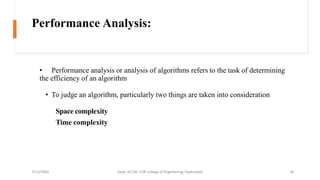
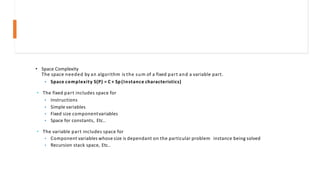
![Examples
Algorithm NEC (float x, float y, float z)
{
Return (X + Y+Y*Z + (X + Y+Z)) /(X+ Y) + 4.0;
}
In the above algorithm, there are no instance characteristics and the space
needed by X, Y, Z is independent of instance characteristics, therefore we can
write, S(XYZ) =3+0=3 One space each for X, Y and Z
Space complexity is O(1).
Algorithm ADD ( float [], intn)
{
sum := 0.0; for i:=1 to n do
sum:=sum +X[i]; return sum;
}
Here, atleast n words since X must be large enough to hold the n elements to be summed.
Here the problem instances is characterized by n, the number of elements to be summed. So,
we can write, S(ADD) =3+n 3-one each for n, I and sum Where n- is for](https://image.slidesharecdn.com/introductiontoalgorithms-200712120726/85/Introduction-to-algorithms-38-320.jpg)
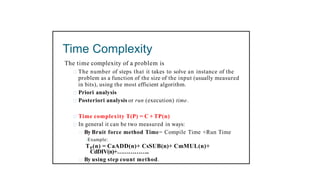
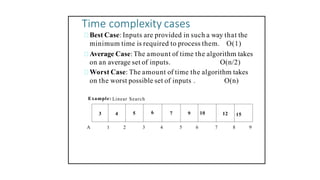
![Contd….
2. Global variable count method:
Statement S/e Frequency Total steps
1. Algorithm Sum(a, n) 0 - 0
2. { 0 - 0
3. s:=0; 1 1 1
4. for i:=1 to n do 1 n+1 n+1
5. s:=s+a[i]; 1 n n
6. return s; 1 1 1
7. } 0 - 0
Total 2n+3 steps
Ex:](https://image.slidesharecdn.com/introductiontoalgorithms-200712120726/85/Introduction-to-algorithms-41-320.jpg)

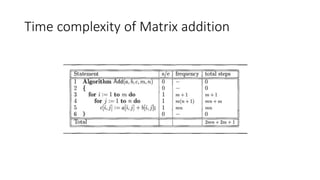
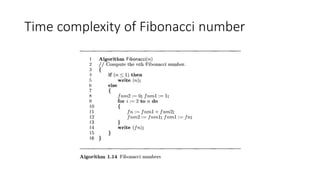
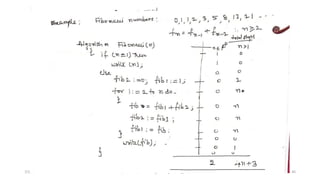
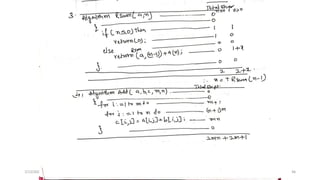
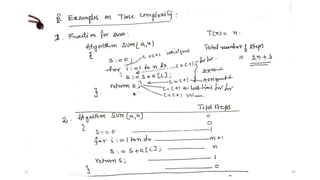
![Contd….
Step count method have two approaches:
1. Global variable count method:
Example:
Algorithm Sum(a, n)
{
s:=0;
for i:=1 to n do
{
s:=s+a[i];
}
return s;
}
Algorithm sum with count statement added
count:=0;
Algorithm Sum(a,n)
{
s:=0;
count:=count+1;
for i:=1 to n do
{
count:=count +1;
s:=s+a[i];
count:=count+1;
}
count:=count+1; //for last time of for loop
count:=count+1; //for return statement
return s;
}
Thus the total number of steps are 2n+3](https://image.slidesharecdn.com/introductiontoalgorithms-200712120726/85/Introduction-to-algorithms-48-320.jpg)
